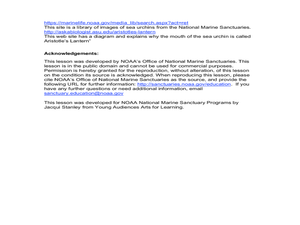Curated Video
How the Starfish Got Its Arms
The story of how the starfish got its arms reminds us that even animals that might be familiar to us today can have incredibly deep histories - ones that stretch back almost half a billion years.
Bozeman Science
Ecosystem Ecology
In this video Paul Andersen explains how ecosystems function. He begins with a description of how life on the planet is ordered from large to small in biomes, ecosystems, communities, population, and individuals. He describes the major...
TED-Ed
TED-ED: The science of symmetry - Colm Kelleher
When you hear the word symmetry, you might think generally of triangles, butterflies, or even ballerinas. But defined scientifically, symmetry is _a transformation that leaves an object unchanged." Huh? Colm Kelleher unpacks this...
Brave Wilderness
Fantastic Sea Creatures…and Where to Find Them!
In this segment of On Location, Coyote, Mark and Mario embark on an epic snorkeling adventure all around the isle of Kauai in the Hawaiian Islands! Their mission was simple - scout for future scuba diving locations and sample the...
Science360
Ocean Acidification -- Changing Planet
As higher amounts of carbon dioxide become absorbed by the oceans, some marine organisms are finding it's a struggle to adjust. The Changing Planet series explores the impact that climate change is having on our planet, and is provided...
Learning Mole
I WONDER - Where Do Invertebrates Live?
This video is answering the question of where do invertebrates live.
Brave Wilderness
LIVING BALL OF SPIKES!
On this episode of Breaking Trail, Coyote attempts to pickup and hold one of the spiniest creatures on the planet…the Echidna! Native to Australia, Echidnas are one of only two mammals in the world that actually lay eggs! Is that unique...
Weird History
Weirdest Foods From Ancient Rome
The people of ancient Rome may have lived thousands of years ago, but their diets were anything but old-fashioned. In fact, they chowed down on many foods we would shudder to even consider consuming today. The rich and famous, ranging...
SciShow
Dangerously Smart: Why This Fish Almost Beached Itself
Fish are smarter than you think! Scientists have explored triggerfish's ability to learn some clever hunting tactics.
Deep Look
Sea Urchins Pull Themselves Inside Out To Be Reborn
Sea Urchins live for centuries if they can make it to adulthood. The video highlights the challenges of sea urchins making the journey through the open sea for years. When they finally find a place to land, an amazing transformation occurs.
Curated OER
investigating and Modeling Sea Urchin Fertilization and Development
Young scholars begin by using clay to model fertilization and early development of sea urchins and chordates. They move on to mixing live sea urchin sperm and ova together to observe, diagram and record events occurring in fertilization...
California Academy of Science
Spiky Sight
Can an organism with no eyes still see? As it turns out for the purple sea urchin, the answer is yes. In a short video, scientists explain why they believe that some sea urchins can use their spikes to visually sense the environment.
Curated OER
Sea Urchin Embryology
Students explore the process of evolution. They examine examples of how homeotic genes may work and obtain gametes. Using a microscope, students observe the fertilization of sea urchins. They video tape the process and write a...
Curated OER
Using Sea Urchins as a Bioassay
Students observe how to spawn male and female pencil sea urchins. They mix together the sperm and ova from the live sea urchin to observe and record the events occurring in the control and experimental groups for fertilization. Thus,...
Curated OER
The Disappearing Kelp Forest
Learners observe the effect "El Nino" left on kelp plants and sea urchins. They analyze the data collected by researchers, by graphing it on a TI calculator. Before graphing and analyzing the data, you may want to revisit the events of...
NOAA
Deep-Sea Ecosystems – Life is Weird!
A pool of brine in the deep sea can be up to four times as salty as the surrounding sea water. The deep sea ecosystem relies on chemosynthesis and the organisms that live there are often strange to us. The lesson focuses on researching...
Curated OER
Critters in the Classroom
Students investigate with sea urchins. In this ocean habitat lesson, students observe sea urchins and other ocean grazers. Students work with lab equipment to examine the anatomy of these creatures.
Curated OER
Sea Urchins - Diadema Antillarum
Pupils investigate oceanography by painting sea life. In this crustacean lesson, students identify sea urchins in our ocean environments and describe the functionality of their spherical-shaped bodies. Pupils design their own sea urchins...
Curated OER
Life is Weird
Separate your science class into small groups and assign each a specific deep-sea organism to research. The class will learn about all of the organisms as each group presents their assigned animal. Following their presentations, you can...
Carnegie Mellon University
Ocean Acidification
After brainstorming what they know about ocean acidification, youngsters place eggs in acid to determine the effects on calcium-containing organisms, and add carbon dioxide to solutions with sea shell material to discover the impact on pH.
Bozeman Science
Phases of Mitosis
You slough off all your skin cells once every seven years. Thank goodness for mitosis, or we would all be looking pretty strange without skin. The video begins by reviewing the cell cycle, looks at an overview of cells undergoing...
Curated OER
Down in the Dumps
After an introduction to municipal sludge, middle school ecologists consider the pros and cons of dumping in the Hudson River Canyon. The class is split into two groups: one to debate in favor or dumping and one to debate against the...
Curated OER
Ocean -- Under The Sea
Students participate in hands-on activities dealing with what lives in the ocean. They also read literature about the oceans.
















